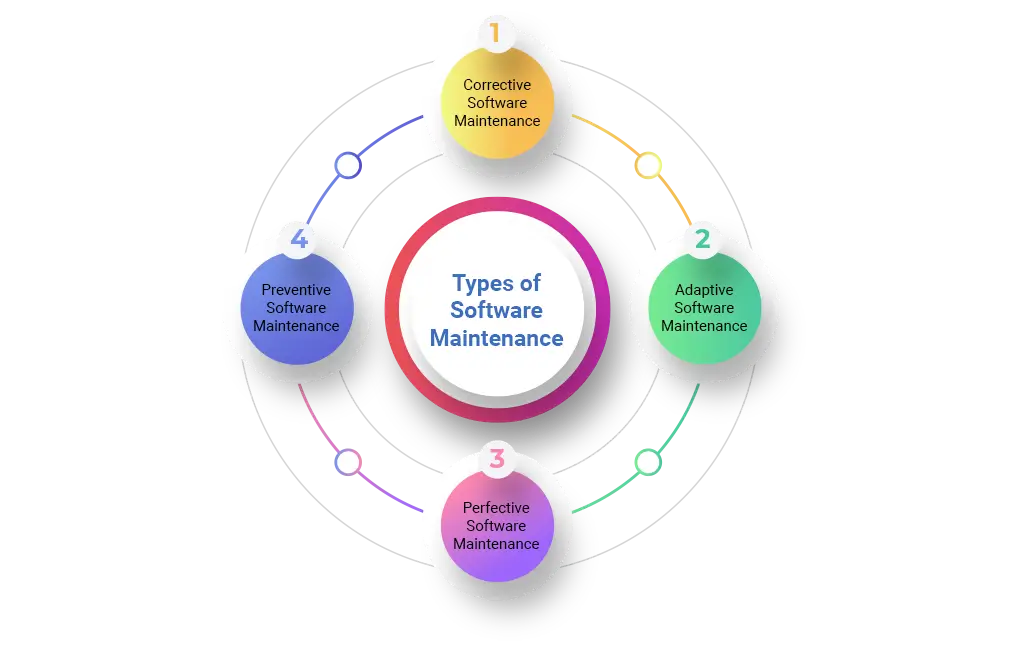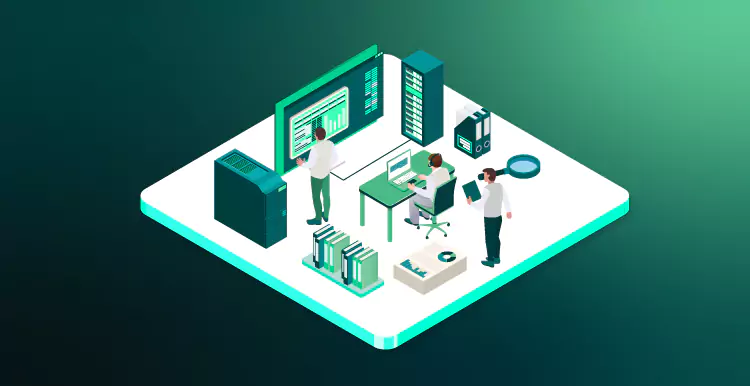Software maintenance is no longer an afterthought – it's a critical investment. Just like a well-maintained car, consistently updating and maintaining your software ensures optimal performance, enhanced security, and a positive user experience.
This article explores the importance of software maintenance, highlighting its impact on security, user experience, costs, lifespan, adaptability, and competitive advantage. Understanding these benefits allows organizations to maximize their software investments and achieve long-term success.
Types of Software Maintenance
Corrective Maintenance
Corrective maintenance is the process of identifying and rectifying errors or defects within a software system. These issues can arise from various sources, including coding mistakes, design flaws, or unforeseen circumstances. Common triggers include user complaints about unexpected behavior, system failures, or crashes.
To address these problems, software developers implement various solutions such as patch releases, hotfixes, and bug fixes. Ultimately, the primary goal of corrective maintenance is to restore the software's functionality to its intended state, ensuring it operates correctly and reliably.
Adaptive Maintenance
Adaptive maintenance involves modifying software to align with changes in its operational environment. These changes can encompass new hardware, operating systems, or external regulations. Triggers can include advancements in technology, modifications in government policies, or alterations in business rules.
To accommodate these changes, the software undergoes modifications such as upgrading to function with a new database system or implementing measures to comply with updated data privacy regulations. Finally, the purpose of this maintenance type is to ensure the software remains functional and effective amidst these evolving conditions.
Perfective Maintenance
Perfective maintenance focuses on enhancing a software product's overall quality. This involves improving its performance, reliability, and usability. This type of maintenance can be triggered by factors:
- User feedback indicating desired features or areas for improvement.
- Performance bottlenecks affecting the software's speed or responsiveness.
- The identification of opportunities to add new functionalities.
Perfective maintenance aims to increase user satisfaction and overall system effectiveness. To achieve this, software developers implement changes such as incorporating new features, optimizing code to eliminate performance bottlenecks, and refining the user interface for improved usability and efficiency.
Preventive Maintenance
Preventive maintenance is a proactive approach to software upkeep that focuses on preventing issues before they occur. This approach aims to minimize downtime, reduce the frequency of critical errors, and extend the software's lifespan.
Preventive maintenance is initiated through regular inspections and evaluations of the software system. By systematically identifying potential problems within the software, developers can implement changes and improvements to enhance the software's stability, reliability, and overall performance.

7 Importances Of Software Maintenance
Improved Functionality and Performance
Software maintenance is essential for improving the functionality and performance of software development. Regular maintenance includes important bug fixes, code optimization, and new feature additions. This tackles security vulnerabilities with timely patches, leading to a better user experience, reduced downtime, and a higher return on investment (ROI).
Businesses can benefit significantly from this improvement, such as:
- Enhanced Productivity: Improved performance leads to greater efficiency and productivity for users.
- Reduced Downtime: Proactive maintenance minimizes system failures, reducing costly downtime.
This comprehensive software maintenance approach applies to various software types, including web, mobile, desktop, and enterprise applications.

Enhanced Security
New software vulnerabilities like zero-day exploits, SQL injection, and cross-site scripting (XSS) assaults are continually discovered. Software maintenance enables the prompt delivery of crucial security fixes and urgent updates, protecting your system against emerging cyberattacks and data breaches. Regular penetration testing and vulnerability scanning are critical for detecting and addressing security flaws before they can be exploited. Besides, businesses can also adhere to security regulations to avoid hefty fines and legal repercussions.

>> Read more:
- Security Testing in Software Testing
- Top 7 Web App Security Testing Tools
- Top 14 Best Data Security Software For Your Businesses
Better User Experience
Users value a system free of significant flaws, minors usability issues, performs swiftly, offers a consistent and intuitive user interface (UI), and includes the latest features. Regular usability testing helps detect and address UI/UX design issues, boosting user satisfaction and loyalty.
Besides, better user experiences can also lead to:
- Higher User Retention: A well-maintained software reduces user frustration and churn.
- Enhanced Brand Reputation: A product with a great user experience builds a strong brand reputation, leading to positive word-of-mouth and business growth.
- Increased Customer Satisfaction: A well-maintained software delivers a superior user experience, leading to higher customer satisfaction and loyalty.
- Increased Revenue: Happy customers are more likely to make additional purchases or upgrades, increasing profitability for the business.

>> Read more:
- The UX Design Process: 7 Steps for UX Designers
- 12 Essential Technical & Soft Skills for UX Designers
Reduced Costs
Taking a proactive approach to software maintenance can result in significant long-term cost savings. This is more cost-effective than addressing severe system breakdowns and the associated downtime. A reactive maintenance strategy also keeps the codebase clean, enhancing development efficiency.
With a significant cost reduction for the software development process, businesses can:
- Increased Profitability: Lower operational costs and extended software lifespan contribute to improved profitability.
- Improved ROI: By maximizing the return on the initial software investment, maintenance enhances overall ROI.

Software Life Extension
Software maintenance extends the lifespan of your software by responding to changing requirements, integrating new technologies, deploying security updates, and improving code quality. This ensures your software remains a valued asset for years, potentially delaying costly upgrades or migrations and avoiding legacy system issues.

Adaptability To Changes
The evolving landscape of corporate requirements, technological advancements, regulations, security concerns, and user preferences necessitates adaptable software. Software maintenance promotes adaptability by directly addressing environmental changes, proactively anticipating possible concerns, and quickly responding to new market trends or customer requests. This ensures software effectiveness and success in a dynamic context.
Moreover, quickly adapting to market changes allows businesses to seize opportunities and mitigate risks. Innovative and responsive web design solutions attract customers and drive growth, staying ahead of competitors and crucial for long-term success.

Competitive Advantages
Software maintenance is frequently underestimated as a strategic tool for gaining a competitive edge. It improves customer satisfaction through continuous improvements, increases market share with superior products, and improves operational efficiency for cost savings and reinvestment. All of them result in a faster time-to-market for new products and risk mitigation through strong security measures, driving business growth.
Besides, businesses can also get benefits such as:
- Innovation Catalyst: A stable and efficient software platform that supports innovation and experimentation, fostering a culture of creativity and adaptability.
- Long-term Sustainability: Regular maintenance extends the software's lifespan, reducing costs, minimizing disruptions, and ensuring the business's long-term sustainability.

Considerations for Effective Software Maintenance
Effective software maintenance is essential for ensuring a software system's longevity, performance, and user satisfaction. Several key considerations must be taken into account when you need to make effective software maintenance for your project as:
- Comprehensive Maintenance Planning: A well-structured maintenance plan outlines the types of maintenance required, resource allocation, and a timeline for tasks. It should also include strategies for change management and impact assessment.
- Strong Documentation: Detailed and up-to-date documentation is crucial for understanding the software's architecture, codebase, and functionalities. It aids in troubleshooting, making modifications, and transferring knowledge among team members.
- Prioritization of Maintenance Tasks: Not all maintenance tasks are equally critical. Prioritization based on impact, urgency, and risk helps allocate resources efficiently and ensures that critical issues are addressed promptly.
- Version Control: Implementing a robust version control system is essential for tracking changes, reverting to previous versions if necessary, and managing multiple software releases.
- User Feedback: Gathering and analyzing user feedback helps identify areas for improvement, prioritize maintenance tasks, and ensure the software meets user needs.
- Continuous Improvement: Software maintenance should be an ongoing process. Regularly reviewing and refining maintenance practices helps optimize efficiency and effectiveness.
By carefully considering these factors, organizations can establish a robust software maintenance program that maximizes system uptime, performance, and user satisfaction.
Conclusion
The allure of new development often overshadows software maintenance, but its importance is undeniable. It is the foundation for keeping software secure, efficient, and relevant in an ever-changing technological context.
Prioritizing software maintenance allows firms to protect their investments, improve user satisfaction, reduce costs, extend software lifespan, stimulate agility, and ultimately gain a competitive advantage. A strong maintenance strategy is not just an expense, but a strategic necessity for long-term success.
>>> Follow and Contact Relia Software for more information!
- development

